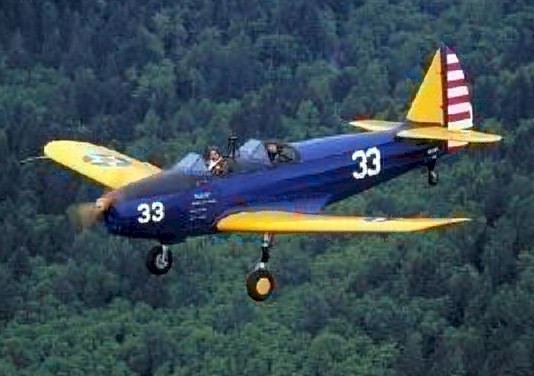|

PT-19 N52164, flown by Ken Dorsch and owned by Curt
Kinchen (now owned by John Armbrust.) Photo by Neville Dawson, Classic Wings Downunder.
History: Basic flight training
in the United States prior to World War II was generally provided in light biplanes, which
tended to be slow, stable and tolerant of fledgling pilots. Thus, the majority of U.S.
Army Air Corps primary training in 1940 was still being done in biplanes like the Boeing-Stearman PT-13/17 series. However, given the increasingly
high-performance nature of the world's combat aircraft, the Army reasoned that the primary
training was too easy, giving the beginner a false sense of mastery that could, on the
next leg up, slow down his learning, or even cause him to fail, when he was prematurely
thrust into more demanding aircraft. Experienced instructors wanted the primary trainer to
be a monoplane, with higher wing loading that demanded more careful flying. Such reasoning
led the USAAC to evaluate the Fairchild M62 two-seat monoplane in 1939.
With a wing loading factor roughly 43 percent higher than the Boeing-Stearman
PT-13, the Fairchild had a higher stalling speed and required a good deal more care at low
speed, making it exactly what the Army was looking for, a trainer that would more nearly
resemble the fighter aircraft the trainees would eventually fly. Following its evaluation,
USAAC ordered 270 of the craft, with two open cockpits, as the PT-19
"Cornell," powered by a Ranger L-440 six-cylinder, inverted, air-cooled inline
engine of 175 horsepower.
When the Army placed massive orders for primary trainers, Fairchild increased the
plane's power with an upgraded, 200 hp Ranger engine, and the plane became the PT-19A.
To meet the increasing demand, the PT-19A was also built by the Aeronca and St. Louis
aircraft companies, with a total of more than 3,700 built.
More than 900 of a blind-flying version, the PT-19B, were
also built. With its instruments for blind flying, the PT-19B could be fitted with a hood
over the front cockpit to simulate blind flying conditions. Fairchild built 774 of the B
models, with Aeronca building another 143.
When a shortage of Ranger engines developed, Fairchild installed a Continental
R-670 radial engine of 220 hp on the PT-19 airframe, that variant being designated PT-23.
While the less-streamlined engine cowling reduced the plane's performance slightly, for
the training role the loss was not significant.
The final version of the PT-19 series, an enclosed-cockpit version designated the PT-26,
was designed for the Royal Canadian Air Force in 1942 with a canopy over the two cockpits.
670 of the PT-26s were provided to the RCAF through Lend-Lease and, in a variation on the
Lend-Lease theme, the U.S. Army Air Force ordered 1,057 PT-26s from the Canadian
manufacturer, Fleet Aircraft, Ltd. All PT-26s were equipped with the 200 hp Ranger engine.
A total of 7,742 Cornells were manufactured for the AAF, 4,889 of them PT-19s, with
additional Cornells being furnished to Canada, Norway, Brazil, Ecuador and Chile.
Nicknames: "Cradle of the Air
Force"
Specifications (PT-26A):
Engine: One 200-hp Ranger L-440 six-cylinder inverted inline piston engine
Weight: Empty 2,022 lbs., Max
Takeoff 2,736 lbs.
Wing Span: 36ft. 0in.
Length: 27ft. 8.5in.
Height: 7ft. 7.5in.
Performance:
Maximum Speed:
122 mph
Ceiling: 13,200
ft.
Range: 400 miles
Armament: None
Number Built: 7,742
Number Still Airworthy: At least 100 (all
variants).
 [ Mark Denest's beautiful PT-26 ] [ Mark Denest's beautiful PT-26 ]
 [ Boots McCormick's
pilot report on the PT-26 ] [ Boots McCormick's
pilot report on the PT-26 ]
PT-19 Cockpit Photo:

(Click for larger)
PT-26 Cockpit Photo:

(Click for larger)
Links:
Bernard Hinkle's
Account of WWII PT-19 Primary Flight Training
CAF Dixie Wing PT-26
CAF Ghost Squadron Cornell Page
CAF Wisconsin Wing,
Waukesha, WI -- Operators of PT-26 N103JC.

Canadian Warplane
Heritage PT-26
Cavanuagh
Flight Museum (Texas, USA) PT-19
March Field Air Museum's PT-19B
Riffle Aviation -- Fairchild PT
aircraft information and manuals on CD-ROM.

[Back to Warbird Alley's Main
Page]
All text and photos Copyright 2016 The Doublestar Group, unless otherwise noted.
You may use this page for your own, non-commercial reference purposes only.
 |